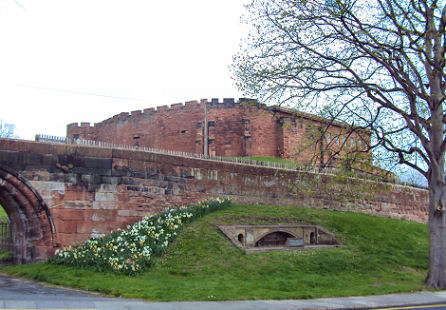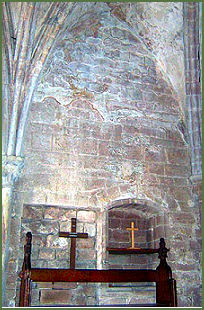Chester Castle
OS grid ref:- SJ404657
 Chester Castle is a motte and bailey fortress, which was founded in Norman times by Hugh de Avranches, Earl of Chester, otherwise known as Lupus, meaning the wolf. The castle sits on a small sandstone hill overlooking the River Dee, in the south west corner of the city walls.
Chester Castle is a motte and bailey fortress, which was founded in Norman times by Hugh de Avranches, Earl of Chester, otherwise known as Lupus, meaning the wolf. The castle sits on a small sandstone hill overlooking the River Dee, in the south west corner of the city walls.
Chester was the last Saxon burgh to fall during his subjugation of northern England, during the final stages of the Harrying of the North in 1069-70, half the Saxon houses in Chester were pulled down to accommodate the new castle. Hugh Lupus erected a typical Norman timber Motte and Bailey castle on the site which was later replaced in stone. From the southern corner of town wall, the castle commands the bridge over the River Dee.
 Only fragments of the 12th century inner bailey curtain wall remain. The Agricola Tower is one of the oldest surviving buildings in the castle and dates to around 1200. On its first floor, situated above the entrance passage, is the chapel of St Mary de Castro (pictured right). The chapel contains items of Norman architecture. Wall paintings which are said to date from around 1220 were revealed when the layers of internal whitewash were removed in the 1980s (below right). When the tower was refaced
in 1837 the foundations of one of the corners was found to be built on a Roman arch and in n 1831 a small piece of a Roman tombstone was found in the wall near the southeast part of the tower.
Only fragments of the 12th century inner bailey curtain wall remain. The Agricola Tower is one of the oldest surviving buildings in the castle and dates to around 1200. On its first floor, situated above the entrance passage, is the chapel of St Mary de Castro (pictured right). The chapel contains items of Norman architecture. Wall paintings which are said to date from around 1220 were revealed when the layers of internal whitewash were removed in the 1980s (below right). When the tower was refaced
in 1837 the foundations of one of the corners was found to be built on a Roman arch and in n 1831 a small piece of a Roman tombstone was found in the wall near the southeast part of the tower.
In the thirteenth century, during the reign of King Henry III, who took the Earldom of Chester for himself, the walls of an outer bailey were built, the gateway in the Agricola Tower was blocked up and residential accommodation, including a Great Hall, was erected along the south wall of the inner bailey. Later in the century, during the reign of his son, King Edward I, a new gateway to the outer bailey was built. This was flanked by two half-drum towers and had a drawbridge over a moat 8 metres (26 ft) deep. Further additions to the castle at this time included individual chambers for the King and Queen, a new chapel and stables. Chester Castle was the frontier base from which North Wales was attacked and eventually conquered in the 12th and 13th centuries and the exchequer, courts and prison were based here, as well as housing the garrison.
Prominent people held as prisoners in the crypt of the Agricola Tower were King Richard II, following the usurpation of his throne by his cousin Henry IV, Richard was murdered at Pontefact Castle in Yorkshire the following year, probably by starvation. Eleanor Cobham, wife of Henry IV's youngest son, Humphrey, Duke of Gloucester, was also incarcerated in the Agricola Tower, for using astrologers to predict the kings death, as was Andrew Moray, hero of the Battle of Stirling Bridge, who was taken hostage in 1296 following the Battle of Dunbar.
The oldest stone tower at Chester Castle was the Flag Tower, which stood at the centre of the motte. The lower half of the tower still survives.
The castle sustained serious damage during the Civil War, when it was held by the Royalists. By the eighteenth century had deteriorated into a very decayed state. Most of the medieval buildings and towers were demolished In the eighteenth century to faciliate the construction of a new barrack block and the Assize County Courts, built by Thomas Harrison, with the car park giving the layout of the outer bailey.
